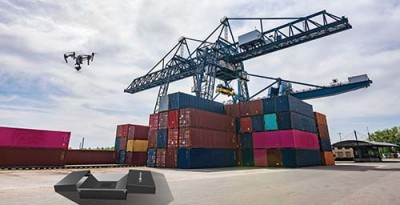Following up the first and second parts of this series about Germany and The Netherlands, respectively, Belgium is next. Known as the Capital of Europe, Belgium is pioneering some aspects of drone use. In Belgium, near Sint-Truiden, the DronePort campus is entirely dedicated to drone research, development, and testing, and the port of Antwerp-Bruges, which hosted the first European BVLOS flight on 21 June 2022, is the base for one of the most advanced drone projects in Europe. Belgium is also actively preparing for a future and airspace in which unmanned aviation can develop. But how are drones being used across this country?
Mapping 8 miles of underground technical galleries
A campaign launched by the Maintenance and Inspection Department at Brussels Mobility led Brussels Mobility, an administrative body of the Brussels region, to survey technical galleries and networks underneath the city. Since some of these galleries were built decades ago and didn’t have up-to-date records, the idea of this campaign was to map the galleries to plan maintenance jobs more efficiently and optimize how these spaces are managed.
To create a detailed as-built resource to understand the situation, Brussels Mobility partnered with specialists in data collection and processing. As inspection service providers across a variety of industries in Belgium, Medexon and Flywel were tasked with inspecting hazardous, confined spaces as well as scouting areas before human entry. Due to potential hazards such as electrical cables potentially being in water due to drainage faults or large equipment blocking the way, the team used an Elios 3 with a Surveying Payload to survey challenging underground sites, including storm drains. After nine days of data collection, the team performed 241 flights across 8 miles, recording 1,776 points of interest.
Building a network of emergency response drones
Every year, thousands of people get injured or lose their lives because of fires, flooding, or other emergencies in Belgium. Making quick and effective decisions with incomplete information in these situations can lead to wasted time in the process of saving lives. Active in various sectors, including industry, public services, education, healthcare, and smart cities, Citymesh introduced SENSE in 2023 to change with a drone grid across Belgium.
Comprised of two Drone-in-a-Box (DiaB) solutions deployed per emergency zone, amounting to a total of 70 safety drones, police and fire services can have real-time situational awareness within the first 15 minutes of an emergency call, allowing commanders to quickly identify the best plan of action depending on the type of distress call. Thanks to Citymesh’s 5G network, these always-ready drones capture high-definition 4K and thermal images and use AI to provide crucial information, enhancing the speed and effectiveness of emergency interventions.
“We are the first Belgium to go from a smart city to a smart country,” said Hans Similon, General Manager - Citymesh Safety Drones. “We believe very hard in this story at Citymesh, this can really save lives.”
Providing security to massive events
Tomorrowland, one of the largest electronic dance music festivals in the world, hosts around 400,000 attendees from over 200 countries each July. Ensuring the safety and security of the Belgium-based event is no easy task, which is why the Police District of Rupel, responsible for security at Tomorrowland, partnered with SkeyDrone, a drone hardware and software developer.
“Even without considering the threat of drones carrying weapons or explosives, a small drone crashing into the crowd can trigger widespread panic and lead to many injuries,” Peter Muyshondt, Chief of Police Police District Rupel, stated. “Monitoring drone traffic is a new and challenging task for the police. Since we lack the necessary resources and expertise, we partnered with SkeyDrone as drone detection is a part of their core business.”
To address possible unauthorized manned and unmanned aviation, possession of drone equipment was prohibited in the area around the festival site, and a temporary no-fly zone was installed above the festival terrain and its surroundings. While only drones belonging to emergency services and the organization were allowed to fly in the area, SkeyDrone’s Drone Radar software detected a total of 104 drone flights in real time. Although many of those flight reports belonged to media and security drones, the system detected 23 unauthorized drones and helped the police confiscate 12 illegal drones by pinpointing the pilots’ locations. Violations of the air traffic regulations were documented through screenshots and reports, and reported to the Belgian Civil Aviation Authority, resulting in fines up to €8,000.
Reshaping the way ports operate
Spanning more than 46 square miles, the port of Antwerp, Belgium, provides a challenge to carry out core tasks, such as berth management, monitoring, infrastructure inspections, oil spills, and floating waste detection. With its D-HIVE DiaB network, DroneMatrix plans to change that by providing improved safety, immediacy, and efficiency over traditional methods, especially in harsh conditions.
With D-HIVE, the port of Antwerp saw the introduction of six autonomous drones performing 18 daily BVLOS flights remotely controlled from a Command-and-Control Centre in the heart of the port. According to DroneMatrix, this innovation plays a pivotal role in establishing a digital twin of the port and facilitates not only efficient port management but also ensures smoother and safer traffic flow, making it an invaluable asset for the port authority.
“This drone network will play a crucial role in the further roll-out of the port's digital twin, a digital copy based on thousands of pieces of data from a network of cameras, sensors, and drone, giving a real-time picture of what is happening at the port every second,” said Jacques Vandermeiren, CEO of Port of Antwerp-Bruges. “This first takes us an important step further in developing a fully digital nervous system.”















Comments